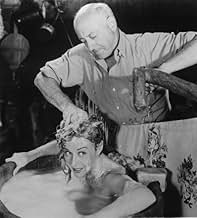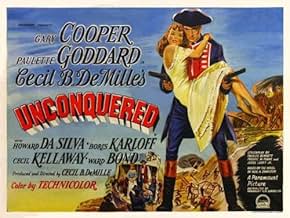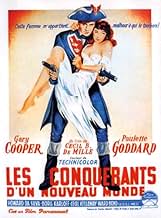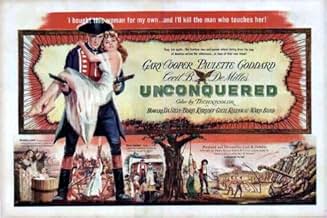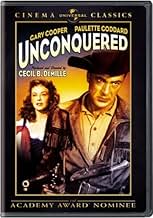CALIFICACIÓN DE IMDb
6.9/10
3.2 k
TU CALIFICACIÓN
Chris Holden, intrépido hombre de la frontera, frustra las ambiciones políticas y personales del renegado Martin Garth en el Valle de Ohio tras la guerra entre franceses y nativos.Chris Holden, intrépido hombre de la frontera, frustra las ambiciones políticas y personales del renegado Martin Garth en el Valle de Ohio tras la guerra entre franceses y nativos.Chris Holden, intrépido hombre de la frontera, frustra las ambiciones políticas y personales del renegado Martin Garth en el Valle de Ohio tras la guerra entre franceses y nativos.
- Dirección
- Guionistas
- Elenco
- Nominado a 1 premio Óscar
- 1 nominación en total
Howard Da Silva
- Garth
- (as Howard da Silva)
Katherine DeMille
- Hannah
- (as Katherine De Mille)
C. Aubrey Smith
- Lord Chief Justice
- (as Sir C. Aubrey Smith)
Opiniones destacadas
Cecil B. DeMille was one of the pioneers of the American film industry, and you have to give him credit for that. He was also one of the first to pack his films with gratuitous sex and violence, and you have to give him credit for that. He got away with it by inserting preachy moral "messages" that proved the "evil" of everything he had just shoved in your face, and you have to give him credit for that. His films were enjoyable in a goofy sort of way, but that doesn't apply to this one.
There's one thing that DeMille could never be accused of, and that's cutting corners. His movies were expensive, and they looked it. They were usually also packed with well-known stars such as Gary Cooper and Charlton Heston. The one thing that few of his movies had, though, was a coherent script, and this movie is a prime example. Stars, production values, spectacle...whatever advantages this film has are sunk by the absolutely idiotic dialogue the actors are forced to spew out. You have to wonder what the actors were thinking as they were reciting this drivel. You also have to wonder what the writers were thinking as they were whipping this junk up; didn't they realize that people don't even _remotely_ talk or act like they do in this movie? Everything in this film is overblown, overheated and overdone. The only other one of DeMille's films I can think of offhand that goes even further over the edge is "Northwest Mounted Police," which is so jaw-droppingly awful it should be classified as a comedy.
As long as you realize what you're getting into, the movie is fun in a goofball, campy sort of way. If you're looking for anything else, forget it.
There's one thing that DeMille could never be accused of, and that's cutting corners. His movies were expensive, and they looked it. They were usually also packed with well-known stars such as Gary Cooper and Charlton Heston. The one thing that few of his movies had, though, was a coherent script, and this movie is a prime example. Stars, production values, spectacle...whatever advantages this film has are sunk by the absolutely idiotic dialogue the actors are forced to spew out. You have to wonder what the actors were thinking as they were reciting this drivel. You also have to wonder what the writers were thinking as they were whipping this junk up; didn't they realize that people don't even _remotely_ talk or act like they do in this movie? Everything in this film is overblown, overheated and overdone. The only other one of DeMille's films I can think of offhand that goes even further over the edge is "Northwest Mounted Police," which is so jaw-droppingly awful it should be classified as a comedy.
As long as you realize what you're getting into, the movie is fun in a goofball, campy sort of way. If you're looking for anything else, forget it.
It's Saturday Afternoon at the Bijou time, courtesy of the over-the-top presentation of Cecil B. DeMille. The film is rich in atmosphere and with an eye for detail in capturing colonial America, no matter how ludicrous the situations may be at times. Yes, the casting of Boris Karloff as an Indian chief is a camp enthusiast's delight but, if taken in the right spirit, only adds to the fun.
The film is highlighted by an action set piece involving an escape from the Indians and a plunge over a waterfall. No credibility whatsoever as far as the real world is concerned. But who says this is the real world? It's the movies where the impossible can happen and we are along for the ride which includes the wonderful Technicolor enhancing of its many visual pleasures.
I can't recommend Unconquered enough for those adventure seekers fully prepared to suspend their sense of disbelief in advance, and it may be the only film ever made about Pontiac's Rebellion, although, Pontiac is never mentioned.
The film is highlighted by an action set piece involving an escape from the Indians and a plunge over a waterfall. No credibility whatsoever as far as the real world is concerned. But who says this is the real world? It's the movies where the impossible can happen and we are along for the ride which includes the wonderful Technicolor enhancing of its many visual pleasures.
I can't recommend Unconquered enough for those adventure seekers fully prepared to suspend their sense of disbelief in advance, and it may be the only film ever made about Pontiac's Rebellion, although, Pontiac is never mentioned.
I am no fan of Cecil B. DeMille, but I actually quite liked 'Unconquered'. Other DeMilles (especially those set in antiquity) are mealstroms of poor writing and worse pacing, with often genuinely talented actors being forced to utter painfully bombastic lines of dialogue. In 'Unconquered', the pacing is rather uneven, too, but there is a bit of real suspense and the dialogues are not as bad. The plot is of course totally over the top, with lots of implausible turns and twists (beginning with the character played by Paulette Goddard travelling to exactly the same place in the American interior as the one played by Gary Cooper). Cooper is a convincing hero, Goddard is far less convincing as - well, what is she? Not quite a damsel in permanent distress, but no heroine either. Anyway, Howard Da Silva is a suitably nasty villain and Boris Karloff a relatively dignified chief of the Seneca. All in all, this makes for a quite satisfying mix.
It's 1763 and two men Capt. Christopher Holden (Gary Cooper) and trader Garth (Howard Da Silva) taking the same ship back to Virginia from London bid for the contract of a woman named Abby (Paulette Goddard) who was given a choice between execution in England or 14 years of indentured servitude in the colonies. The winner Holden gallantly frees her and leaves the ship to join his girlfriend about to marry her . The loser who illegally sells guns to the local Seneca Indians destroys the contract and manages Abby working in his saloon . Along the way Cooper suffers assaults and has to help the settlers fight Indians and escaping from savage natives. Crimson-haired slave girl . . . desired by a man of destiny! Together they shared the thrills of the most daring spectacle De Mille ever filmed !They live again¡ Dauntless men and women who kept America unconquered ¡. I bought this woman for my own..and I'll kill the man who touches her!From A People Like This Came America's Heritage. In A Story Like This Lies America's Greatness!
Lavish film , in fact producers spent a reported 4 million dollar to bring to life this thrilling and moving melodrama , and most of it shows up on the big screen, while outstanding the heroic derring-do of Cooper including the overwhelming getaway by Gary along with Paulette over treacherous and wild rapids and falls that result to be most notable among the colorful set pieces . This is a spectacular adventure combining melodrama with improbability and garnishes it with hokum enough . Containing some splendidly staged scenes in which Gary Cooper has to keep rescuing Goddard throughout the film as well as fighting Da Silva . As Gary Cooper is very good , as usual , as the brave hero attempting to foil plans of controlling the Ohio Valley and to deliver peace belts to the Indians who have already sent out war belts. And female strring Paulette Goddard is frankly gorgeous . Adding a nice gallery of villains as Howard Da Silva as an eminently hissable nasty playing the scurvy trader , Boris Karloff making an unusual appearance as an Indian chief . Furthermore , other illustrous secondaries as Cecil Kellaway, Ward Bond, Katherine DeMille , Henry Wilcoxon , C. Aubrey Smith ,Mike Mazurski , Porter Hall, Jane Nigh, Alan Napier , Raymond Hatton and Marc Lawrence .
It displays a colorful photography from Ray Rennahan , and shot on location in Allegheny Mountain, Pittsburgh, Pennsylvania, , Big Mesa Falls, Ashton, Idaho, Wolf Creek, New York State,Conejo Grade, Los Angeles,Snake River, Clearwater River,Idaho . Including excellent special effects by Academy Award winning Gordon Jennings . Along with impressive production design by Hans Dreier and Walter Tyler . Thrilling as well as romantic musical score by the classic Victor Young . This vigorous motion picture was realized in Cecil B DeMille's ordinary style , supported by a magnificent second unit by Harold Rosson ; both of them made some greatests spectacles of all time .DeMille especiality was spectacle and he certainly delivers a full measure of it. Although a nimbler action filmmaker than Cecil might have made even more of the Oscar-winning effects work . Cecil produced and directed 70 films and was involved in many more . Many of his films were romantic sexual comedies , as he is supposed to have believed that Americans were curious only about money and sex . His best-known were biblical epics that further established him as the symbol of Hollywood such as ¨King of Kings¨ (1927), The ten Commandments (1923) , ¨The Crusades¨(1935) , ¨Reap of the wild wind¨ (1949) , and , of course , Charlton Heston's ¨Ten commandments¨ (1956) and he made two versions about ¨The Buccaneer : 1938 and 1958¨ that was ended by Anthony Quinn and Arthur Rosson . Rating : 7/10 . Well worth watching . Better than average
Lavish film , in fact producers spent a reported 4 million dollar to bring to life this thrilling and moving melodrama , and most of it shows up on the big screen, while outstanding the heroic derring-do of Cooper including the overwhelming getaway by Gary along with Paulette over treacherous and wild rapids and falls that result to be most notable among the colorful set pieces . This is a spectacular adventure combining melodrama with improbability and garnishes it with hokum enough . Containing some splendidly staged scenes in which Gary Cooper has to keep rescuing Goddard throughout the film as well as fighting Da Silva . As Gary Cooper is very good , as usual , as the brave hero attempting to foil plans of controlling the Ohio Valley and to deliver peace belts to the Indians who have already sent out war belts. And female strring Paulette Goddard is frankly gorgeous . Adding a nice gallery of villains as Howard Da Silva as an eminently hissable nasty playing the scurvy trader , Boris Karloff making an unusual appearance as an Indian chief . Furthermore , other illustrous secondaries as Cecil Kellaway, Ward Bond, Katherine DeMille , Henry Wilcoxon , C. Aubrey Smith ,Mike Mazurski , Porter Hall, Jane Nigh, Alan Napier , Raymond Hatton and Marc Lawrence .
It displays a colorful photography from Ray Rennahan , and shot on location in Allegheny Mountain, Pittsburgh, Pennsylvania, , Big Mesa Falls, Ashton, Idaho, Wolf Creek, New York State,Conejo Grade, Los Angeles,Snake River, Clearwater River,Idaho . Including excellent special effects by Academy Award winning Gordon Jennings . Along with impressive production design by Hans Dreier and Walter Tyler . Thrilling as well as romantic musical score by the classic Victor Young . This vigorous motion picture was realized in Cecil B DeMille's ordinary style , supported by a magnificent second unit by Harold Rosson ; both of them made some greatests spectacles of all time .DeMille especiality was spectacle and he certainly delivers a full measure of it. Although a nimbler action filmmaker than Cecil might have made even more of the Oscar-winning effects work . Cecil produced and directed 70 films and was involved in many more . Many of his films were romantic sexual comedies , as he is supposed to have believed that Americans were curious only about money and sex . His best-known were biblical epics that further established him as the symbol of Hollywood such as ¨King of Kings¨ (1927), The ten Commandments (1923) , ¨The Crusades¨(1935) , ¨Reap of the wild wind¨ (1949) , and , of course , Charlton Heston's ¨Ten commandments¨ (1956) and he made two versions about ¨The Buccaneer : 1938 and 1958¨ that was ended by Anthony Quinn and Arthur Rosson . Rating : 7/10 . Well worth watching . Better than average
I saw this film in the theater when I was nine. All I and my contemporaries cared about was shooting and dying. Years later I wondered why Colonel Bouquet spoke accented English. Some mild research turned up the fact that Colonel wa an historic figure. Bouquet was a Swiss mercenary who commanded troops for the Brits. Who ever expected that level of hitoricity from De Mille. I leave to others to research whether the flag over the british fort was correct.
¿Sabías que…?
- TriviaWhile Boris Karloff was filming his scenes, he had his customary 4:00 p.m. tea break, which he always had written into his contract. They became so popular that even Gary Cooper and Charles Chaplin came on set for tea, and Paulette Goddard had a 4:00 p.m. tea break written into her contracts for the rest of her career.
- ErroresAlthough working as a slave, Abby has perfectly applied makeup and lipstick.
- Citas
Lord Chief Justice: Slavery in the colonies or the gallows here? Speak up, girl! Which is it to be?
Abby: [Resignedly] Slavery, My Lord.
- ConexionesFeatured in Cecil B. DeMille: American Epic (2004)
- Bandas sonorasWHIPPOORWILL'S A SINGIN'
(uncredited)
Written by Victor Young and Phil Boutelje
Lyrics by Jay Livingston and Ray Evans
Selecciones populares
Inicia sesión para calificar y agrega a la lista de videos para obtener recomendaciones personalizadas
- How long is Unconquered?Con tecnología de Alexa
Detalles
Taquilla
- Presupuesto
- USD 5,000,000 (estimado)
- Tiempo de ejecución
- 2h 26min(146 min)
- Relación de aspecto
- 1.37 : 1
Contribuir a esta página
Sugiere una edición o agrega el contenido que falta


